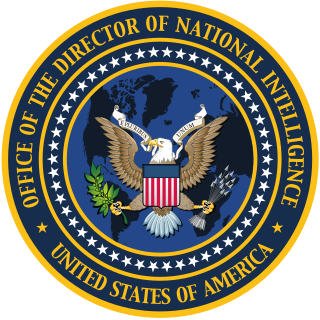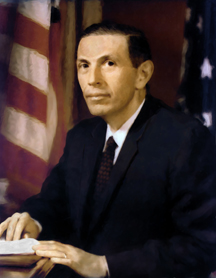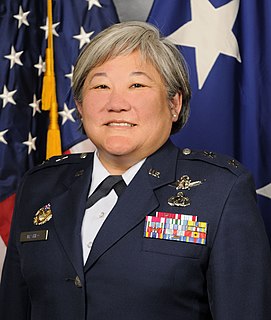Related Research Articles

The National Reconnaissance Office (NRO) is a member of the United States Intelligence Community and an agency of the United States Department of Defense which designs, builds, launches, and operates the reconnaissance satellites of the U.S. federal government, and provides satellite intelligence to several government agencies, particularly signals intelligence (SIGINT) to the NSA, imagery intelligence (IMINT) to the NGA, and measurement and signature intelligence (MASINT) to the DIA.

The Director of National Intelligence (DNI) is a cabinet-level United States government official, required by the Intelligence Reform and Terrorism Prevention Act of 2004 to serve as head of the United States Intelligence Community and to direct and oversee the National Intelligence Program (NIP). The DNI also serves, upon invitation, as an advisor to the President of the United States and the executive offices of the National Security Council and the Homeland Security Council about intelligence matters related to national security. The DNI produces the President's Daily Brief (PDB), a top-secret document including intelligence from all the Intelligence Community agencies, given each morning to the president.
Misty is reportedly the name of a classified project by the United States National Reconnaissance Office (NRO) to operate stealthy reconnaissance satellites. The satellites are conjectured to be photo reconnaissance satellites and the program has been the subject of atypically public debates about its worthiness in the defense budget since December 2004. The estimated project costs in 2004 were, at the time of statement, US$9.5 billion.
The Aerospace Corporation is an American California nonprofit corporation that operates a federally funded research and development center (FFRDC) headquartered in El Segundo, California. The corporation provides technical guidance and advice on all aspects of space missions to military, civil, and commercial customers. As the FFRDC for national-security space, Aerospace works closely with organizations such as the United States Air Force Space and Missile Systems Center (SMC) and the National Reconnaissance Office (NRO) to provide "objective technical analyses and assessments for space programs that serve the national interest". Although SMC and NRO are the primary customers, Aerospace also performs work for civil agencies as well as international organizations and governments in the national interest.

Fort Belvoir is a United States Army installation and a census-designated place (CDP) in Fairfax County, Virginia, United States. It was developed on the site of the former Belvoir plantation, seat of the prominent Fairfax family for whom Fairfax County was named. It was known as Camp A. A. Humphreys from 1917–1935 and Fort Belvoir afterward.

Lieutenant General Lincoln D. Faurer was United States Air Force officer who served as Director of the National Security Agency and Chief of the Central Security Service from 1981 to 1985.

Thomas Samuel Moorman Jr. was a United States Air Force officer who served as Vice Chief of Staff of the United States Air Force from July 1994 to August 1997.

Dino Antonio Brugioni was a former senior official at the CIA's National Photographic Interpretation Center (NPIC). He was an imagery analyst and also served as NPIC's Chief of Information. During his 35-year career, Brugioni helped establish imagery intelligence (IMINT) as a national asset to solve intelligence problems. Even after retirement, Brugioni was considered to be the world's foremost imagery intelligence analyst.

Lieutenant General John T. "Tom" Sheridan retired from the US Air Force in August 2011. His last assignment was as Commander, Space and Missile Systems Center, Los Angeles AFB, California; he was succeeded by Ellen M. Pawlikowski in June 2011. He has been VP of the SI's National Security Space program since 16 April 2012 ,.
The Director of the National Reconnaissance Office (DNRO) of the United States is responsible to the Secretary of Defense and the Director of National Intelligence for all national space and assigned airborne reconnaissance activities. The DNRO provides top-level management direction to the NRO in response to Secretary of Defense and Director of National Intelligence requirements.

Jeffrey K. Harris is an American aerospace executive who served as 11th director of the National Reconnaissance Office from 1994 to 1996. He is currently the chairman of the board of the United States Geospatial Intelligence Foundation.

Alexander Henry Flax was the Chief Scientist of the U.S. Air Force (USAF) from 1959 to 1961, Assistant Secretary of the Air Force for Research and Development from 1963 to 1969, and the third Director of the National Reconnaissance Office (NRO) from 1965 to 1969. He was the director at a time when the second generation of imaging systems became operational and began to play a major role in United States intelligence during the Cold War. He oversaw major growth in NRO funding and personnel, the development of signals intelligence collectors from space, and the development of electro-optical imaging for US reconnaissance satellites.

Betty Jean Sapp is the former Director of the National Reconnaissance Office (DNRO). She served as a United States Air Force Officer and employee of the Central Intelligence Agency. She was the first female Director of the NRO.

Susan K. Mashiko is a retired United States Air Force major general who served as the Deputy Director, National Reconnaissance Office, Chantilly, Virginia. Her responsibilities include assisting the director and principal deputy director in managing the strategic and tactical operations of the NRO. Also, as the commander, Air Force Space Command Element, she manages all air force personnel and resources assigned to the NRO and serves as the senior adviser to the DNRO on all military matters. Mashiko is the first Japanese American woman to be promoted to flag rank.

Paul G. Kaminski is a technologist and former U.S. government official, best known for his leading role in the development of stealth aircraft.

Deirdre Walsh is Vice President of Washington, D.C. Operations for Ball Aerospace & Technologies. Previously as a federal government employee and member of the United States Intelligence Community, she served as the first chief operating officer (COO) for the Office of the Director of National Intelligence from February 2018 to May 2020.

Robert Evans Greer was a United States Air Force (USAF) officer who attained the rank of major general. A graduate of the United States Military Academy at West Point, New York, where he was ranked 175th in the class of 1939, he served in China and the Mariana Islands during World War II. After the war he served in the USAF Office of the Assistant for Atomic Energy and as vice commander of the Space Systems Division of the Air Force Systems Command.

Donna D. Shipton is a major general in the United States Air Force who currently serves as Director of Strategic Plans, Programs, Requirements, and Analyses, Headquarters Air Force Materiel Command at Wright-Patterson Air Force Base, Ohio. She previously served as vice commander of the Space and Missile Systems Center of the United States Space Force. She was responsible for assisting the commander in managing the research, design, development, acquisition, and sustainment of space and missile systems, launch, command and control, and operational satellite systems. Shipton was replaced as vice commander of the Space and Missile Systems Center in June 2020 by D. Jason Cothern.

Donald Jason Cothern is a brigadier general in the United States Air Force currently serving as the vice commander of the Space and Missile Systems Center of the United States Space Force. Prior to his current assignment, he was the assistant program director for development at the F-35 Lighting II Joint Program Office, where he was responsible for F-35 fighter fifth generation modernization activities.
References
- ↑ Laurie, Clayton. Leaders of the National Reconnaissance Office 1961-2001. Office of the Historian, National Reconnaissance Office. 1 May 2002.
- ↑ "National Reconnaissance Office Press Release 12". Archived from the original on 2009-08-13. Retrieved 2010-01-03.
- ↑ "Missile Defense Expert and W&J Graduate to Speak March 16 at His Alma Mater". Today @ W&J. Washington & Jefferson College. March 8, 2010. Archived from the original on July 17, 2012. Retrieved March 23, 2010.CS1 maint: discouraged parameter (link)
- ↑ "W&J: David Kier". W&J People Profiles. Washington & Jefferson College. Retrieved 2010-03-23.CS1 maint: discouraged parameter (link)[ permanent dead link ]
- ↑ "Homecoming festivities start tonight at W&J". Observer-Reporter . Oct 3, 2002. Retrieved 2010-03-23.
David Kier, a 1965 graduate of W&J, will speak about his 21-year career in the Central Intelligence Agency, during which he designed, developed and operated U.S. satellite systems. His presentation will begin at 8 tonight in the ballroom of Rossin Campus Center.
CS1 maint: discouraged parameter (link) - ↑ "W&J alum to speak on missile defense". Observer Reporter . March 9, 2010. Retrieved 2010-03-23.CS1 maint: discouraged parameter (link)[ dead link ]
